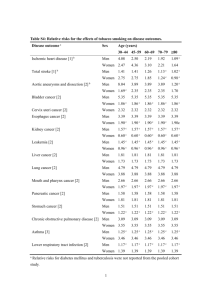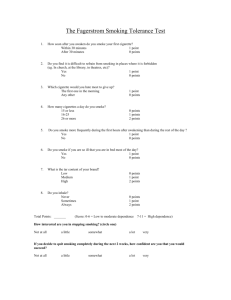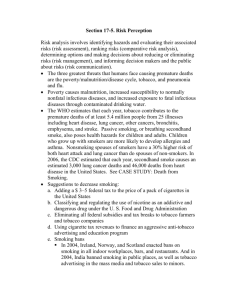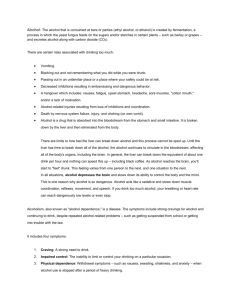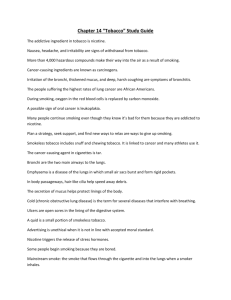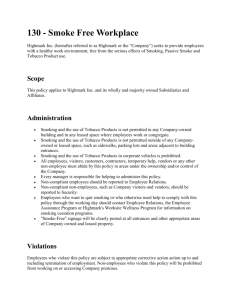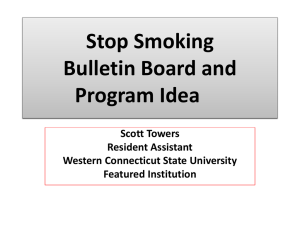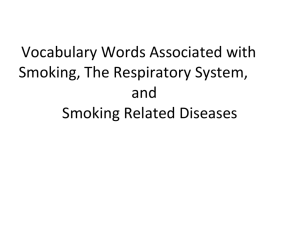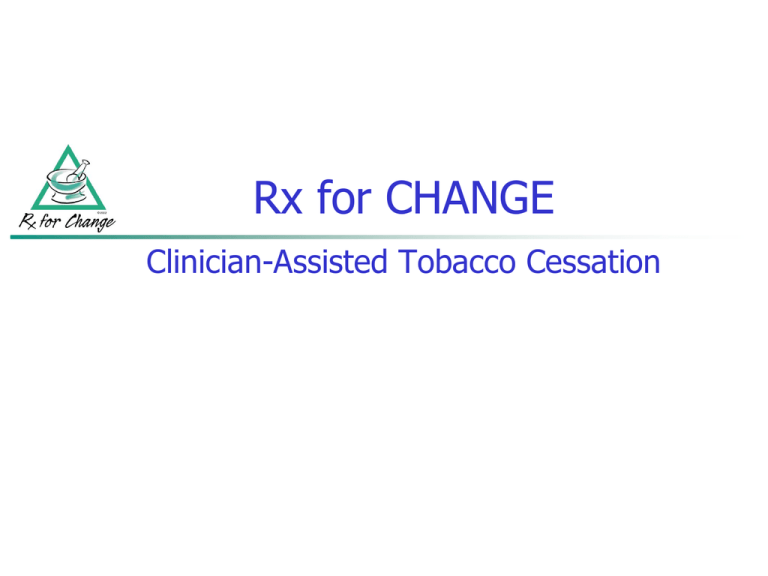
Rx for CHANGE
Clinician-Assisted Tobacco Cessation
TRAINING OVERVIEW
Epidemiology of Tobacco Use
Nicotine Pharmacology & Principles of Addiction
Drug Interactions with Smoking
Assisting Patients with Quitting
Aids for Cessation
Tobacco Trigger Tapes
Role Playing with Case Scenarios and Video Counseling
Sessions
EPIDEMIOLOGY
of TOBACCO USE
“CIGARETTE
SMOKING…
is the chief, single,
avoidable cause of death
in our society and the most
important public health
issue of our time.”
C. Everett Koop, M.D., former U.S. Surgeon General
All forms of tobacco are harmful.
WORLDWIDE ADULT TOBACCO
USE PREVALENCE (Men/Women)
Canada
24/17
Russian Federation
59/24
France
36/27
Greece
63/41
China
51/2
USA
21/15
Mexico
24/8
UK/
Northern Ireland
25/23
Japan
42/12
Philippines
47/10
Iran
26/2
Brazil
22/13
South Africa
36/10
Kiribati
71/43
India
26/4
Papua New
Guinea
58/31
Australia
22/19
World Health Organization Report on the Global Tobacco Epidemic (2011).
U.S. updates from: Centers for Disease Control and Prevention (CDC). (2014). MMWR 63:1108-1112.
TRENDS in ADULT CIGARETTE
CONSUMPTION—U.S., 1900–2011
Annual adult per capita cigarette consumption and major smoking and health events
Number of cigarettes
1964 Surgeon
General’s Report
Broadcast
ad ban
End of WW II
Master
Settlement
Agreement;
California
first state to
enact ban on
smoking in
bars
Marketing
of filtered
cigarettes
U.S. entry into
WW I
First modern
reports linking
smoking and
Great Depression cancer
Nonsmokers’
rights movement
begins
Cigarette
price drop
Federal cigarette
tax doubles
20 states
have > $1
pack tax
Year
Centers for Disease Control and Prevention (CDC). (1999). MMWR 48:986–993.
Per-capita updates from U.S. Department of Agriculture and (since 2000) Centers for Disease Control
and Prevention (CDC). (2012). MMWR 61:565–569.
CIGARETTE PRICES and
CIGARETTE SALES, 1970–2013
Sales (million packs)
29,500
Sales
Price
$5.50
27,500
$5.00
25,500
$4.50
23,500
$4.00
21,500
$3.50
19,500
$3.00
17,500
$2.50
15,500
$2.00
13,500
Price per pack (2014 dollars)
$6.00
$1.50
1970
1975
1980
1985
1990
1995
2000
2005
2010
Chaloupka FJ. (2015). The economics of tobacco taxation. Chicago, IL:
ImpacTEEN, University of Illinois at Chicago.
TRENDS in ADULT SMOKING,
by SEX—U.S., 1955–2013
Trends in cigarette current smoking among persons aged 18 or older
60
Percent
50
17.8% of adults
are current
smokers
Males
40
30
20
Females
20.5%
15.3%
10
0
1955
1960
1965
1970
1975
1980
1985
1990
1995
2000
2005
2010
Year
69% want to quit
53% tried to quit in the past year
Graph provided by the Centers for Disease Control and Prevention. 1955 Current Population
Survey; 1965–2013 NHIS. Estimates since 1992 include some-day smoking.
STATE-SPECIFIC PREVALENCE of
SMOKING among ADULTS, 2013
Prevalence of
current* smoking
(2013)
< 13.0%
13.0 – 15.9%
16.0 – 18.9%
19.0 – 21.9%
≥ 22.0%
* Has smoked ≥ 100 cigarettes during lifetime and currently smokes either every day or some days.
PREVALENCE of ADULT SMOKING,
by RACE/ETHNICITY—U.S., 2013
26.8%
Multiple race
26.1%
American Indian/Alaska Native
White
19.4%
Black
18.3%
Hispanic
12.1%
Asian
9.6%
0
10
20
30
Percent
Centers for Disease Control and Prevention (CDC). (2014). MMWR 63:1108–1112.
PREVALENCE of ADULT SMOKING,
by EDUCATION—U.S., 2013
24.2%
No high school diploma
41.4%
GED diploma
22.0%
High school graduate
20.9%
Some college
9.1%
Undergraduate degree
5.6%
Graduate degree
0
10
20
30
40
50
Percent
Centers for Disease Control and Prevention (CDC). (2014). MMWR 63:1108–1112.
TRENDS in TEEN SMOKING, by
ETHNICITY—U.S., 1977–2014
Trends in cigarette smoking among 12th graders: 30-day prevalence of use
50
40
Percent
White
30
Hispanic
20
Black
10
0
1977
1982
1987
1992
1997
2002
2007
2012
Year
Institute for Social Research, University of Michigan, Monitoring the Future Project
www.monitoringthefuture.org
PUBLIC HEALTH versus
“BIG TOBACCO”
The biggest opponent to tobacco
control efforts is the tobacco
industry itself.
Nationally, the tobacco industry is outspending
our state tobacco control funding.
For every $1 spent by the states, the tobacco industry
spends $23 to market its products.
TOBACCO INDUSTRY
MARKETING
$8.37 billion spent in the U.S. in 2011
$23.0 million a day
20
New marketing
restrictions
15
10
5
2011
2010
2009
2008
2007
2006
2005
2004
2003
2002
2001
2000
1999
1998
0
1970
Billions of dollars spent
Year
Federal Trade Commission (FTC). (2013). Cigarette Report for 2011.
The TOBACCO INDUSTRY
For decades, the tobacco industry publicly denied the
addictive nature of nicotine and the negative health effects of
tobacco.
April 14, 1994: Seven top executives of major tobacco
companies state, under oath, that they believe nicotine is not
addictive: http://www.jeffreywigand.com/7ceos.php
Tobacco industry documents indicate otherwise
Documents available at http://legacy.library.ucsf.edu
The cigarette is a heavily engineered product.
Designed and marketed to maximize bioavailability
of nicotine and addictive potential
Profits over people
An EFFECTIVE MARKETING
STRATEGY: “LIGHT” CIGARETTES
The difference between Marlboro and Marlboro Lights…
an extra row of ventilation holes
Image courtesy of Mayo Clinic Nicotine Dependence Center - Research Program / Dr. Richard D. Hurt
The Marlboro and Marlboro Lights logos are registered trademarks of Philip Morris USA.
1932
1936
1990
SMOKING in MOVIES
Cigarette smoking is pervasive in movies
Evident in at least ¾ of box-office hits
Average, 10.9 smoking incidents per hour
Charlesworth and Glantz. (2005). Pediatrics 116:1516–1528.
There is a dose-response, causal
relationship between exposure to
smoking in movies and youth smoking
initiation
Superman II (1980)
National Cancer Institute. (2008). The Role of the Media in Promoting
and Reducing Tobacco Use.
70% of adults support assigning an
“R” rating to movies with smoking.
For more information on smoking in movies, go to http://smokefreemovies.ucsf.edu
FDA REGULATION of
TOBACCO PRODUCTS
The FDA Center for Tobacco Control Products is
responsible for regulation of:
Cigarettes
Cigarette tobacco
Roll-your-own tobacco
Smokeless tobacco
E-cigarettes that are marketed for therapeutic
purposes*
*Currently regulated by the FDA Center for Drug Evaluation and Research. It is anticipated that the
FDA Center for Tobacco Control Products will regulate other nicotine-containing products , including
electronic cigarette products that do not make a therapeutic claim, in the future.
COMPOUNDS in TOBACCO
SMOKE
An estimated 4,800 compounds in tobacco smoke,
including 11 proven human carcinogens
Gases
Carbon monoxide
Hydrogen cyanide
Ammonia
Benzene
Formaldehyde
Particles
Nicotine
Nitrosamines
Lead
Cadmium
Polonium-210
Nicotine is the addictive component of tobacco products,
but it does NOT cause the ill health effects of tobacco use.
ANNUAL U.S. DEATHS ATTRIBUTABLE
to SMOKING, 2005–2009
Percent of all smokingattributable deaths
Cardiovascular & metabolic diseases
160,600
33%
Lung cancer
130,659
27%
Pulmonary diseases
113,100
23%
Second-hand smoke
41,280
9%
Cancers other than lung
36,000
7%
1,633
<1%
Other
TOTAL: >480,000 deaths annually
U.S. Department of Health and Human Services (USDHHS). (2014).
The Health Consequences of Smoking—50 Years of Progress: A Report of the Surgeon General.
ANNUAL SMOKING-ATTRIBUTABLE
ECONOMIC COSTS
Health-care
expenditures
Lost productivity costs
due to premature mortality
$132.5 billion
$156.4 billion
Total economic burden
of smoking, per year
$288.9 billion
Billions of US dollars
Societal costs: $19.16 per pack of cigarettes smoked
U.S. Department of Health and Human Services (USDHHS). (2014).
The Health Consequences of Smoking—50 Years of Progress: A Report of the Surgeon General.
2014 REPORT of the
SURGEON GENERAL:
HEALTH CONSEQUENCES OF SMOKING
MAJOR DISEASE-RELATED CONCLUSIONS:
Cigarette smoking is causally linked to diseases of nearly all
organs of the body, diminished health status, and harm to the
fetus.
Additionally, smoking has many adverse effects on the body, such as
causing inflammation and impairing immune function.
Exposure to secondhand smoke is causally linked to cancer,
respiratory, and cardiovascular diseases, and to adverse effects
on the health of infants and children.
Disease risks from smoking by women have risen over the last
50 years and for many tobacco-related diseases are now equal to
those for men.
U.S. Department of Health and Human Services (USDHHS). (2014).
The Health Consequences of Smoking—50 Years of Progress: A Report of the Surgeon General.
HEALTH CONSEQUENCES
of SMOKING
Cancers
Bladder/kidney/ureter
Blood (acute myeloid leukemia)
Cervix
Colon/rectum
Esophagus/stomach
Liver
Lung
Oropharynx/larynx
Pancreatic
Asthma
COPD
Pneumonia/tuberculosis
Chronic respiratory symptoms
Aortic aneurysm
Coronary heart disease
Cerebrovascular disease
Peripheral vascular disease
Reproductive effects
Pulmonary diseases
Cardiovascular diseases
Reduced fertility in women
Poor pregnancy outcomes (e.g.,
congenital defects, low birth weight,
preterm delivery)
Infant mortality
Other: cataract, diabetes (type 2), erectile
dysfunction, impaired immune function,
osteoporosis, periodontitis, postoperative
complications, rheumatoid arthritis
U.S. Department of Health and Human Services (USDHHS). (2014).
The Health Consequences of Smoking—50 Years of Progress: A Report of the Surgeon General.
HEALTH CONSEQUENCES of
SMOKELESS TOBACCO USE
Periodontal effects
Gingival recession
Bone attachment loss
Dental caries
Oral leukoplakia
Cancer
Oral cancer
Pharyngeal cancer
Oral Leukoplakia
Image courtesy of Dr. Sol Silverman University of California San Francisco
HERMAN ® is reprinted with permission from
LaughingStock Licensing Inc., Ottawa, Canada
All rights reserved.
2006 REPORT of the
SURGEON GENERAL:
INVOLUNTARY EXPOSURE to TOBACCO SMOKE
Second-hand smoke causes premature death and disease
in nonsmokers (children and adults)
Children:
There is no
safe level of
second-hand
smoke.
Increased risk for sudden infant death syndrome
(SIDS), acute respiratory infections, ear problems, and
more severe asthma
Respiratory symptoms and slowed lung growth if parents smoke
Adults:
Immediate adverse effects on cardiovascular system
Increased risk for coronary heart disease and lung cancer
Millions of Americans are exposed to smoke in their homes/workplaces
Indoor spaces: eliminating smoking fully protects nonsmokers
Separating smoking areas, cleaning the air, and ventilation are ineffective
U.S. Department of Health and Human Services (USDHHS). (2006).
The Health Consequences of Involuntary Exposure to Tobacco Smoke: Report of the Surgeon General.
SMOKING BANS in the
UNITED STATES
Smoke-free offices, restaurants, and bars
Data current as of January 2014.
QUITTING:
HEALTH BENEFITS
Time Since Quit Date
Circulation improves,
walking becomes easier
Lung function increases
Excess risk of CHD
decreases to half that of a
continuing smoker
Lung cancer death rate
drops to half that of a
continuing smoker
Risk of cancer of mouth,
throat, esophagus,
bladder, kidney, pancreas
decrease
Lung cilia regain normal
function
2 weeks
to
3 months
1 to 9
months
Ability to clear lungs of mucus
increases
Coughing, fatigue, shortness of
breath decrease
1
year
5
years
Risk of stroke is reduced to that
of people who have never
smoked
after
15 years
Risk of CHD is similar to that of
people who have never smoked
10
years
BENEFICIAL EFFECTS of QUITTING:
PULMONARY EFFECTS
FEV1 (% of value at age 25)
AT ANY AGE, there are benefits of quitting.
Never smoked
or not susceptible
to smoke
100
75
Stopped smoking
at 45 (mild COPD)
Smoked
regularly and
susceptible to
effects of smoke
50
Disability
25
Stopped smoking
at 65 (severe
COPD)
Death
0
25
50
75
Age (years)
COPD = chronic obstructive pulmonary disease
Reprinted with permission. Fletcher & Peto. (1977). BMJ 1(6077):1645–1648.
Cumulative risk (%)
Reduction in
cumulative risk of
death from lung
cancer in men
Age in years
Reprinted with permission. Peto et al. (2000). BMJ 321(7257):323–329.
SMOKING CESSATION:
REDUCED RISK of DEATH
Prospective study of 34,439 male British doctors
Mortality was monitored for 50 years (1951–2001)
Years of life gained
15
On average, cigarette
smokers die approximately
10 years younger than do
nonsmokers.
10
5
0
30
40
50
60
Among those who continue
smoking, at least half
will die due to a
tobacco-related disease.
Age at cessation (years)
Doll et al. (2004). BMJ 328(7455):1519–1527.
FINANCIAL IMPACT of
SMOKING
Buying cigarettes every day for 50 years at $6.18 per pack*
(does not include interest)
$755,177
$338,335
$503,451
$225,570
Packs
per
day
$251,725
$112,785
0
100
200
300
400
Dollars lost, in thousands
* Average national cost, as of December 2014. Campaign for Tobacco-Free Kids, 2014.
EPIDEMIOLOGY of TOBACCO
USE: SUMMARY
Nearly one in five adults are current smokers; smoking
prevalence varies by sociodemographic characteristics.
Nearly half a million U.S. deaths are attributable to smoking
annually.
Smoking costs the U.S. an estimated $288.9 billion annually.
For the individual, a smoking a pack-a-day costs $2,256
annually, plus associated health-care costs.
At any age, there are benefits to quitting smoking.
The biggest opponent to tobacco control efforts is the
tobacco industry.

